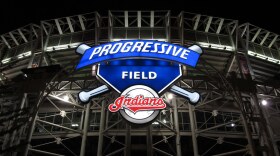Division I college sports are in for big changes following this week’s U.S. Supreme Court decision. The ruling says that the NCAA cannot limit education-related benefits to student athletes for things like computers and internships.
WKSU’s sports commentator Terry Pluto says the decision is considered a first step in eventually paying salaries to some Division I athletes.
Pay the powerhouses
Pluto has long argued that athletes playing for powerhouse schools like Ohio State and Alabama should be paid like pros.
"You're looking at a football game with 100,000 people in the stands and you see millions upon millions of dollars rolling in in corporate suites and television revenue. Coordinators are making a million or two million dollars in some of these schools. And then they build these palaces — not stadiums — But the practice facilities and all these things," Pluto said.
According to Cleveland.com, Ohio State University's athletics department brought in a record of more than $228 million during the 2019-20 fiscal year. That led the department to end that fiscal year with a profit of $5.6 million. The university said athletics suffered a $60 million deficit as a result of the coronavirus pandemic, much less than projected. It will be paying back a loan to the university over the next several years.
"[The ruling] was aimed primarily at these big-money schools, but it has to trickle down to what we have close to home, the mid-majors here."Terry Pluto
An NCAA split?
Pluto said the speculation is that the Supreme Court ruling will lead to the top schools splitting from the NCAA.
"[They would] basically become like a pro league [and] somehow negotiate with somebody representing the athletes a basic labor agreement with a minimum salary. They'll finally just get it over with and be pros. And frankly, I don't care what they do. There's like 300 schools playing Division I basketball. That's like 40 of the 300," Pluto said.
How will mid-majors be affected?
But how the ruling will affect smaller Division I schools like the University of Akron and Kent State University remains to be seen. Those schools consistently run budget deficits to operate their athletic programs because they aren't selling tens of thousands of tickets and don't have big TV contracts.
"[The ruling] was aimed primarily at these big-money schools, but it has to trickle down to what we have close to home, the mid-majors here," he said.
Pluto says if Division I athletes eventually end up being entitled to salaries, these mid-major schools will suffer.
"How about this: You're a student working your way through Akron, Kent or Cleveland State. Already, part of your student fees are going to the athletic department. How would you like your student fees jacked up even more so they can pay $15 an hour for a basketball player at your school? That could be next, because where would they get the money?"
"What it looks like now compared to three years from now, we're going to be shocked at the changes. If these schools are smart, they're going to get out ahead of this."Terry Pluto
A new landscape
Pluto says he's pleased that the Supreme Court ruling will likely lead to changes that the NCAA has been refusing to make for years.
"What it looks like now compared to three years from now, we're going to be shocked at the changes. If these schools are smart, they're going to get out ahead of this and figure out, 'Okay, how are we going to do this?'"
Pluto says the schools would have a couple options.
One option is to drop from Division I to non-scholarship Division III. "The University of Hartford, which was Division I in a number of things, just said, 'Forget it, we're going Division III in everything. We're done.' That could happen," Pluto said.
Another option would be to limit the number of Division I scholarships schools give out and make some sports non-scholarship Division III. "This will hurt some athletes if they do this," Pluto said.
Ohio legislation
Meanwhile, college athletes in Ohio could earn money through endorsements and sponsorship deals based on their names, images and likenesses, under legislation introduced last month.
Since 2019, 16 states — including Arizona, Nebraska, and Michigan — have approved legislation allowing college athletes to make money through advertisements, sponsorship deals and other types of promotions based on their athletic success. Five of those bills become law July 1.








